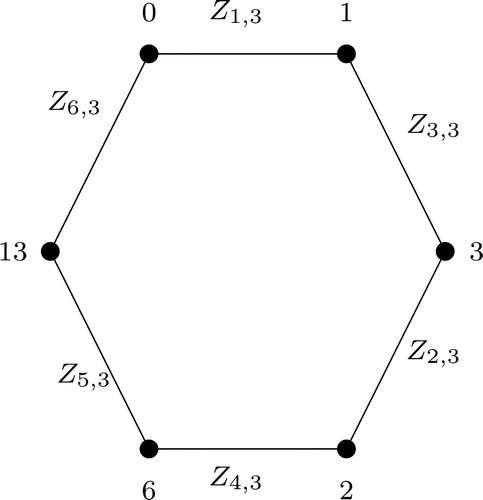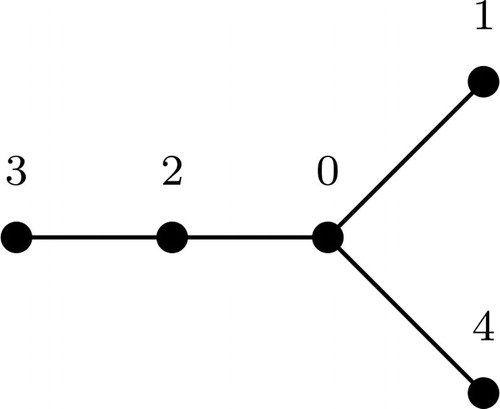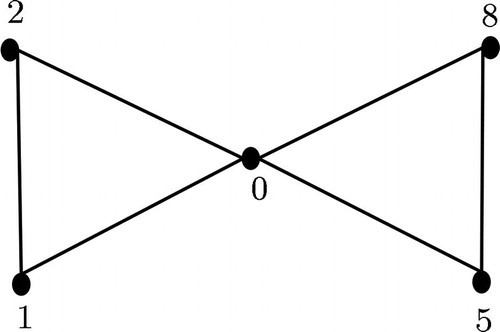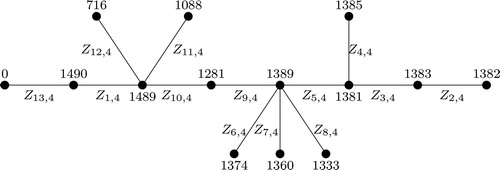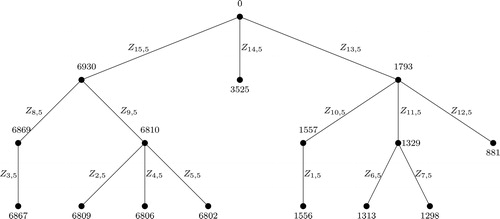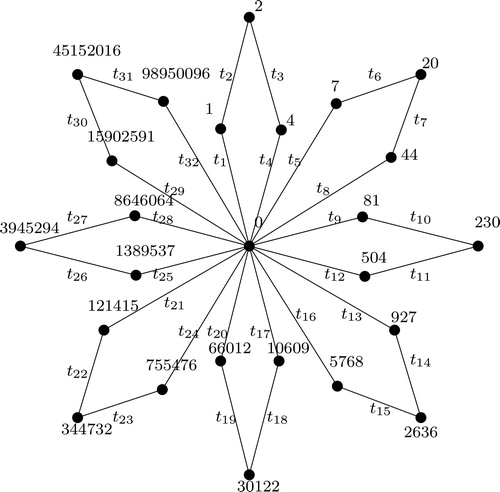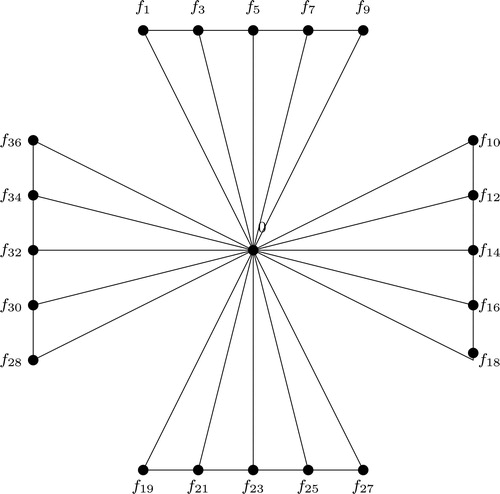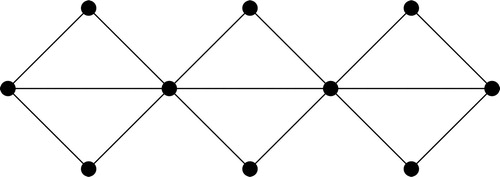 ?Mathematical formulae have been encoded as MathML and are displayed in this HTML version using MathJax in order to improve their display. Uncheck the box to turn MathJax off. This feature requires Javascript. Click on a formula to zoom.
?Mathematical formulae have been encoded as MathML and are displayed in this HTML version using MathJax in order to improve their display. Uncheck the box to turn MathJax off. This feature requires Javascript. Click on a formula to zoom.Abstract
We introduce new labeling called m-bonacci graceful labeling. A graph G on n edges is m-bonacci graceful if the vertices can be labeled with distinct integers from the set such that the derived edge labels are the first n m-bonacci numbers. We show that complete graphs, complete bipartite graphs, gear graphs, triangular grid graphs, and wheel graphs are not m-bonacci graceful. Almost all trees are m-bonacci graceful. We give m-bonacci graceful labeling to cycles, friendship graphs, polygonal snake graphs, and double polygonal snake graphs.
Keywords:
1. Introduction
In 1964, Ringel conjectured that given a tree T with n vertices, the complete graph can be decomposed into
edge-disjoint copies of T [Citation12]. To address this problem, in 1966, Rosa introduced the concept of graceful labeling of graphs as β-valuations [Citation13]. Rosa showed that Ringel’s conjecture holds if all the trees are graceful. From this, the famous Ringel-Kotzig conjecture was formed. The conjecture states that all trees are graceful, which is still open. Several researchers ([Citation1, Citation5], to name a few) have worked on this conjecture and have some partial results.
Golumb in [Citation7], introduced the term graceful. A graceful labeling of a graph on n edges is defined as follows: G is said to be graceful if there exists a function
such that the function
defined by
is a bijection. In 1985, Lo defined edge graceful labeling by assigning labels to the edges of the graph G on p vertices and n edges, from the set
such that the derived vertex labeling is a bijection from V(G) to
[Citation10]. Several researchers ([Citation4, Citation14] to name a few) are working on in this edge graceful labeling.
In [Citation9], Koh et al. defined a tree on n + 1 vertices to be a Fibonacci tree if the vertices can be labeled with the first n + 1 Fibonacci numbers so that the induced edge labeling should be the first n Fibonacci numbers, which were later called as Super-Fibonacci labeling (See [Citation6] for more information). In [Citation2], Bange et al. modified the definition of Koh et al. by relaxing the vertex labels to the set of distinct integers from where Fn is the n-th Fibonacci number. A new group of graphs called Fibonacci graceful graphs was obtained from this definition. A graph on n edges is said to be Fibonacci graceful if there exists a vertex labeling with distinct elements from the set
such that the induced edge labels form a bijection on to the first n Fibonacci numbers. For all other types of graceful labeling, we refer the reader to [Citation6].
In this paper, we extend the concept of Fibonacci graceful to m-bonacci graceful graphs by replacing the Fibonacci numbers with m-bonacci numbers.
The paper is arranged as follows. In Section 2, notations, definition of m-bonacci number and definition and example of m-bonacci graceful labeling are given. Some basic properties of m-bonacci graceful labeling is discussed in Section 3. In Section 4, we find some special graphs which are not m-bonacci graceful. In Section 5, m-bonacci graceful labeling of some special classes of graphs are given. We end the paper with a few concluding remarks.
2. Preliminaries
We refer the reader to [Citation3] for basic concepts and definitions of graphs. By G(p, n), we denote a simple graph on p vertices and n edges. In this paper, we use the following definition for an m-bonacci number. The m-bonacci sequence is defined by
and for
Each
is called an m-bonacci number. For example, when m = 5, the sequence is
In [Citation2], Bange et al. defined a new labeling called Fibonacci graceful labeling. We generalize the definition to any m. We define a new labeling called m-bonacci graceful labeling as follows:
Definition 1.
Let be a graph on p vertices and n edges. G(p, n) is called m-bonacci graceful if there exists a labeling l of its vertices with distinct integers from the set
which induces an edge labeling
defined by
is a bijection onto the set
When m = 2, the above labeling is the Fibonacci graceful labeling. For m = 3, shows a 3-bonacci graceful labeling of C6.
Note that, not all graphs are m-bonacci graceful. Also, if a graph G is m-bonacci graceful for some m, then it does not necessarily imply that G is m-bonacci graceful for all m. For example, consider the graph C6. It was shown in [Citation2], that C6 is Fibonacci graceful and one can see from that C6 is also 3-bonacci graceful. However, C6 is not 4-bonacci graceful. Infact we show that (see Theorem 3) C6 is m-bonacci graceful for all m ≥ 2 and We also give a labeling of the Butterfly graph (see ) such that it is Fibonacci graceful. But one can verify (see Proposition 1) that Butterfly graph is not m-bonacci graceful for all m ≥ 3. We also give an example of a tree () which is m-bonacci graceful for any m ≥ 3, whereas it is not Fibonacci graceful. The famous” Ringel-Kotzig conjecture” states that all trees are graceful. But, the conjecture does not hold for m-bonacci graceful labeling. Some trees are m-bonacci graceful for some m, whereas some trees are not m-bonacci graceful for any m. In , one can see that T1 is 3-bonacci graceful, whereas T2 is not m-bonacci graceful for any m. In fact, we show that (Proposition 2)
is not m-bonacci graceful for any m. If a graph G is not graceful, it is not necessarily true that G is not m-bonacci graceful for any m. For example, shows that the butterfly graph is Fibonacci graceful. But in [Citation13], Rosa showed that any Eulerian graph with edge count congruent to 1 or
is not graceful. Thus, both the butterfly graph as well as C6, are not graceful. We see that the butterfly graph is Fibonacci graceful (see ) but not m-bonacci graceful for all m ≥ 3 (see Proposition 1) and C6 is m-bonacci graceful for all m ≥ 2 and
(see Proposition 1). Hence, we conclude the following.
Observation 1.
The following are true.
There exists a graph that is Fibonacci graceful but not m-bonacci graceful for allm ≥ 3
There exists a graph that is m-bonacci graceful for allm ≥ 3 but not Fibonacci graceful
There exists a graph that is graceful but not m-bonacci graceful for anym ≥ 2
There exists a graph that is m-bonacci graceful for all
but not graceful.
3. Properties of m-bonacci graceful graphs
In this section, we study some basic properties of m-bonacci graceful graphs. From the definition, it is clear that, for a graph to be m-bonacci graceful, one of its edges must have the label which is only possible when 0 and
are the labels for its incident vertices. Moreover, any vertex adjacent to the vertex labeled with 0 must have an m-bonacci number as its label. We first recall some well known properties of m-bonacci numbers [Citation8, Citation11].
Lemma 1.
For , we have the following.
for all
If the sum of m m-bonacci numbers equals another m-bonacci number, then those m + 1 numbers must be consecutive.
The first
terms of the m-bonacci sequence are
Based on the observations in Lemma 1, we deduce the following.
Corollary 1.
For , such that
and t > 0, the following is true.
Proof.
Let and t > 0. Then, we have
Hence, the result. □
We first observe that similar to Fibonacci graceful graphs [Citation2] the labeling of an m-bonacci graceful graph need not be unique, i.e., the graph can have several distinct labeling.
Observation 2.
LetG(p, n) be an m-bonacci graceful graph for some with vertex labels from the set
Then, replacing each vertex labelsai with
also gives an m-bonacci graceful labeling.
It was also observed in [Citation2] that the cycle structure of Fibonacci graceful graphs is dependent on Fibonacci identities. We observe here that the result is also true for any m ≥ 3.
Lemma 2.
Let G(p, n) be an m-bonacci graceful graph and let C be a cycle of length k in G(p, n). Then there exists a sequence with
for all
such that
where
are the derived m-bonacci numbers for the edges of C.
The following corollary is a direct observation from the above Lemma and the fact (See Lemma 1) that if the sum of any m m-bonacci numbers is another m-bonacci number, then these numbers must be consecutive. The corollary gives an edge labeling for cycles of a particular length.
Corollary 2.
Let G be an m-bonacci graceful graph such that G has a cycle C of length . Then, the edges of C must be labeled with m-bonacci numbers
for
, and
for
for some
Thus, from Lemma 2 and Corollary 2, we observe the following, which provides a condition for the edge labels for any cycle in an m-bonacci graceful graph.
Corollary 3.
Let G(p, n) be an m-bonacci graceful graph and C be a cycle in G(p, n). If is the largest m-bonacci number appearing as an edge label of C, then
should also appear as edge labels on C.
The following result gives conditions on the number of edges in any Eulerian m-bonacci graceful graph.
Theorem 1.
Let G(p, n) be an Eulerian m-bonacci graceful graph. Then,
Proof.
Let G be an Eulerian m-bonacci graceful graph. Then, G can be decomposed into edge-disjoint cycles. From Lemma 2, it is clear that the sum of all the edge labels around any cycle is even and hence, is even. But by Lemma 1,
is odd only when
for m ≥ 2. Hence, the result. □
The following result gives a partial information about the cycles of any m-bonacci graceful graph.
Proposition 1.
Any m-bonacci graceful graph can have at most one cycle of length less than or equal to m. From this, we get that, for m ≥ 3, the only maximal outerplanar m-bonacci graceful graph is C3.
Proof.
Let G be an m-bonacci graceful graph and let C be a cycle of G of length n such that Let the vertices of C be m-bonacci gracefully labeled with labels from the set
(since
by Lemma 1,
). Suppose there exists another cycle
of length
in G whose vertices are labeled such that
with k > n is the largest edge label of
Now, by Corollary 3,
are also edge labels of
Since
are the only edge labels and the length of
is m. By Lemma 2, there exists a sequence
with
such that,
(1)
(1)
Note that, the labels are m consecutive m-bonacci numbers. By Corollary 1, EquationEquation (1)
(1)
(1) does not hold true. Thus, an m-bonacci graceful graceful graph can have a maximum of only one cycle of length less than or equal to m. Hence, the result. □
4. Forbidden graphs
In this section, we discuss some special graphs that are not m-bonacci graceful. We start this section with the tree graph. Except K1 and K2, any tree with the number of edges at most three cannot be m-bonacci gracefully labeled, as there does not exist enough integers between 0 and to label n + 1 vertices.
In [Citation2], Bange et al. proved that any graph which has a 3-edge connected subgraph is not Fibonacci graceful. One can observe that the result also holds when m ≥ 3. We omit the proof as it is similar to the proof given by Bange et al.
Theorem 2.
If G has a 3-edge connected subgraph, then G is not m-bonacci graceful for m ≥ 2.
The above result cannot be improved further as cycles are 2-edge connected, and most of them are m-bonacci graceful. The following corollary is a direct observation from Theorem 2.
Corollary 4.
The following graphs are not m-bonacci graceful for m ≥ 2.
Complete graph
The wheel graph
The Generalized Petersen graph
The Fence graph
The Circular ladder graph
We now discuss the case for complete bipartite graphs. One can easily verify that both and
are m-bonacci graceful for all m ≥ 3.
is Fibonacci graceful but
is not Fibonacci graceful. In the following result we show that complete bipartite graphs
except for
and
are not m-bonacci graceful for m ≥ 2.
Proposition 2.
Complete bipartite graphs, except for and
, are not m-bonacci graceful for m ≥ 2.
Proof.
Let Then,
is 3-edge connected. By Theorem 2,
is not m-bonacci graceful for m ≥ 2.
is not m-bonacci graceful. At most either
or
will appear as one of the edge labels (Note that,
).
Now, the only case left is
Let u, v be the two vertices that are adjacent to other n vertices. Let l(u) = 0. Then, all the n vertices should be labeled with m-bonacci numbers. Since
it is impossible to give a label to v distinct from other n + 1 vertices such that the graph is m-bonacci graceful. The proof is similar if a vertex from the other partite set with n vertices gets 0 as vertex label. □
The following result shows that gear graphs are not m-bonacci graceful. Gear graph is obtained by replacing each edge in the perimeter of the wheel graph Wn by a path of length 2. We denote gear graphs by Gn. Gn has vertices. G4 is shown in . G3 is Fibonacci graceful but not m-bonacci graceful
Proposition 3.
Gear graphs are not m-bonacci graceful for all m ≥ 2.
Proof.
Let Gt be a gear graph. Suppose Gt is m-bonacci graceful for some and
Recall that, a gear graph is a subdivision of wheel graph. Let v be the single universal vertex of Gt. Let u1 and u2 be the end vertices of the edge with
as edge label. Note that at least one of the vertices u1 and u2 is of degree greater than 2. Now, we have two different cases.
Case 1: If either u1 or u2 is v, then we get three edge disjoint paths from u1 to u2. So we get a cycle which does not contain the edge with edge label
This is a contradiction to Corollary 3.
Case 2: If both
then
We have the following two subcases:
m ≥ 3: Let u1 be the vertex of degree 3. Let u3 be the vertex of degree 3 such that u2 is adjacent to u3 and u3 is adjacent to v. Now we have two cycles:
and the outer perimeter cycle from u2 to u2. Note that, these two cycles have only two edges in common i.e.,
and
Also, the edge label of
is
and we get a cycle which does not contain either the edge with
as edge label or the edge with
as edge label. Thus for
in either case, it is a contradiction to Corollary 3.
m = 2: Without loss of generality, let v and u1 are adjacent. Let u3 be the vertex adjacent to u2 and v. Let fk denote the k-th Fibonacci number. Consider the cycle
Since fn is an edge label of C, by Corollary 3,
must be an edge label of one of the edges of C. Now, by Lemma 2, we get that
and
are the remaining edge labels (otherwise it will give contradiction to Lemma 2). If the edge label of vu3 is
then by Corollary 3 and Lemma 2, the cycle of length four different from the cycle C, which has vu3 as one of its edge, must have
as edge labels. This is not possible (since
is one of the edge labels of the cycle
). The same contradiction arises for
to be the edge label of vu1. So,
is the edge label of
Without loss of generality, let
and
where
is the derived edge labeling. Now consider the cycles C1 and C2 which have vu1 and vu3 as one of its edges, respectively. Clearly, C1 and C2 does not share any edge (since we consider only
). To satisfy Lemma 2 and Corollary 3, the only possible remaining edge labels of C1 are
This implies that, the largest edge label in C2 is
By Corollary 3,
should be an edge label of one of the edges of C2, which is not possible.
Thus, is not m-bonacci graceful for all
□
4.1. Triangular grid graph
Triangular grid graph is a graph with vertex set and two vertices
and
are adjacent if and only if
We denote such graphs by TGn. The graph TGn has
vertices and
edges. Note that, when n = 0, TGn is K1 and when n = 1, TGn is K3. The graph TG3 is given in . In the following result, we show that
is not m-bonacci graceful
Proposition 4.
The triangular grid graph TGn is not m-bonacci graceful for all
Proof.
Let m ≥ 3. Then, by Proposition 1,
is not m-bonacci graceful. Let m = 2 and
denote the number of edges in TGn. Let fk denote the k-th Fibonacci number. To the contrary, assume that there exists an n such that TGn is Fibonacci graceful. Then, fN is an edge label of some edge uv in TGn. At most one vertex of u and v can have degree 2. Now, we have two cases.
Case 1: If
then the edge uv lies in two different cycles. But, at most one of the two cycles can have
as one of its edge labels. This is a contradiction to Corollary 3.
Case 2: If deg(u) = 2, then let w be another vertex which is adjacent to both u and v in TGn. By Lemma 2 and Corollary 3,
and
are the other two edge labels of the cycle uvwu. If
is the edge label of vw, then another triangle which has vw as one of its edge labels can not have
as one of its edge labels, which is a contradiction to Corollary 3. Hence, the edge label of uw and vw is
and
respectively. Now, consider the triangle vwtv, t is another vertex of TGn adjacent to v and w. Now, by Lemma 2 and Corollary 3, the edge labels are
and
Without loss of generality, let
be the edge label of the edge vt. Now, the triangle different from vtwv and uvwu which has vt as one of its edge can not have
as one of its edge labels, which is a contradiction to Corollary 3.
Hence, the result. □
5. m-Bonacci graceful graphs
In this section, we discuss some special graphs which are m-bonacci graceful. We start the section with cycles. We begin by answering for what values of n and m, Cn is m-bonacci graceful. The following theorem gives a characterization for all cycles Cn that are m-bonacci graceful. In [Citation2], Bange et al found the values of n for which Cn is Fibonacci graceful. The following theorem is the generalization of the result to any m.
Theorem 3.
Let m ≥ 2. The cycle Cn with n vertices is m-bonacci graceful if and only if
Proof.
Consider a cycle Cn of length n. Let
Then,
for some
Let
be the vertices of Cn. We give a labeling for Cn as follows:
(2)
(2)
For
(3)
(3)
Here
Again
Here
and
Hence, all the labels are distinct and positive integers. Proceeding in the same way, we get that all the labels are distinct. The difference of each adjacent vertex label is distinct m-bonacci numbers (clear from the construction of labels). Hence, Cn is m-bonacci graceful.
Conversely, suppose Cn is m-bonacci graceful for some m. One can easily observe that by Theorem 1, Cn is not m-bonacci graceful if From EquationEquations (2)
(2)
(2) and Equation(3)
(3)
(3) , Cn is graceful for
Hence, the result. □
The following corollary gives the vertex label of particular vertices of Cn.
Corollary 5.
Let
be an m-bonacci graceful cycle for some m ≥ 2, and labeled as given in Theorem 3. Then,
is an m-bonacci number for all
Proof.
We prove this result by induction on i. By Theorem 3, we have the following:
Therefore, the result is true for i = 1. Assume that
is an m-bonacci number. Let
for some s. By construction, it is easy to verify that
By Theorem 3, we have,
(4)
(4)
From EquationEquation (4)
(4)
(4) ,
is an m-bonacci number. By induction, the result is true for all i. □
The next simple special class of graph is the tree. For any m, we can give graceful labeling to K1 and K2. For n = 4 and the only tree which cannot be m-bonacci gracefully labeled is
is not m-bonacci graceful for any
(refer Proposition 2). For m ≥ 3, except
all trees with five edges are m-bonacci graceful.
The following theorem provides m-bonacci graceful labeling for any tree with edges more than 5. We omit the proof as it is similar to the proof given by Bange et al. Few examples are shown in the .
Theorem 4.
All trees Tn with , where n denotes the number of edges, except for
, are m-bonacci graceful for all m ≥ 2.
5.1. Friendship graph
The Friendship graph is obtained by joining n copies of Ct with a common vertex. An example of
is given in . By Proposition 1,
is not m-bonacci graceful for all m ≥ 2. In the following result, we find values of t such that the Friendship graph
is m-bonacci graceful for all m ≥ 2.
Theorem 5.
Let m ≥ 2. The friendship graph is m-bonacci graceful for all k ≥ 1
Proof.
Let v be the common vertex with vertex label 0. We denote by the distinct cycles in
Let the vertices of each Ai,
be
in that order. We label the vertices of cycle Ai in a similar way as given in Theorem 3 with the starting label
By Corollary 5,
is an m-bonacci number. The derived edge labels of Ai are:
Thus, the vertex labels and edge labels are distinct and hence the result. □
3-bonacci graceful labeling of is shown in the .
Another variant of Friendship graph denoted by is obtained by joining n copies of Fk with a common vertex, where Fk is a fan on k + 1 vertices. When k = 2,
is nothing but
which is Fibonacci graceful. Thus, we take k > 2. Note that, by Proposition 1, the fan graph Fk for k > 2 and
are not m-bonacci graceful for all
The following result gives a Fibonacci graceful labeling of
for
Theorem 6.
The friendship graph is Fibonacci graceful for all
and
Proof.
Let v be the common vertex and let denote the n copies of the fan graph Fk respectively. Let the vertices of Ai be
such that uij is adjacent with vertex v for all
and uij is adjacent with vertex
for all
Label the vertex v as 0.
For we label the vertices of Ai as follows:
Clearly, the vertex labels and edge labels are distinct. Thus,
is Fibonacci graceful. □
A Fibonacci graceful labeling of is given in .
5.2. Polygonal snake graph
A polygonal snake graph is obtained from a path Pt by replacing each edge of Pt by Cn i.e., for each edge in the path Pt a cycle of length n is adjoined. It is denoted by where t denotes the number of vertices of the path and n denotes the number of edges of the cycle Cn. Hence,
has
vertices and
edges. An example is shown in .
Theorem 7.
The Polygonal snake graph is m-bonacci graceful for all
and m ≥ 2.
Proof.
Let denote the polygonal snake graph with
vertices and
edges and let
be the cycles of
in that order. Denote the vertices of Ai by
for all
Note that,
for all
We label the vertices of A1 as follows:
Here,
Thus, the vertex labels of A1 are all distinct. Now, we have the following:
(5)
(5)
Thus, the derived edge labels are
We have
We now label the vertices of
inductively as follows:
Clearly, for a given Ai,
(6)
(6)
and for
we have the following:
(7)
(7)
where,
Since M1 adds at most m – 1 consecutive m-bonacci numbers, from EquationEquation (7)(7)
(7) , we have
Thus, all vertices of the polygon Ai for
have distinct labels. We now show that for any two Ap and Aq,
such that
the vertex labels of Ap and Aq are all distinct. We first prove the following claim.
Claim: For we have
and
From EquationEquation (7)(7)
(7) , we get that
Since
we have
The only thing left to prove is
We have that,
(8)
(8)
Also we have,
(9)
(9)
From EquationEquations (8)
(8)
(8) and Equation(9)
(9)
(9) , we get
since
Hence,
and the claim holds.
By claim and EquationEquation (6)(6)
(6) , it is clear that the vertex labels of
are all distinct. We now show that the vertex labels of A1 and Ai for
are distinct. In A1 we have,
(10)
(10)
We have from EquationEquation (6)
(6)
(6) ,
Hence, by the above claim and EquationEquation (10)
(10)
(10) , the vertex labels of
are all distinct from each other. By calculation, we get that
By construction, other edge labels are distinct m-bonacci numbers. Hence,
is m-bonacci graceful. □
A 4-bonacci labeling of is given in .
5.3. Double polygonal snake graph
The double polygonal snake graph denoted by is obtained from the path with edges
by adjoining two different cycles of length n to each ei as the common edge for all
Note that, has
vertices and
edges. An example of such a graph is given in .
Theorem 8.
The double polygonal snake graph is m-bonacci graceful for all m ≥ 2.
Proof.
The graph has
vertices and
edges. Let Ai and Bi denote the two different cycles associated with edge ei of the path Pt,
Let uij and wij denote the vertices of cycles Ai and Bi respectively,
For each i such that
we have
We label the vertices of A1 as follows:
(11)
(11)
Clearly the vertex labels are distinct as
Also, we have the following:
(12)
(12)
From EquationEquations (11)
(11)
(11) and Equation(12)
(12)
(12) , the derived edge labels of the edges of A1 are
We now label the vertices of B1 as follows:
(13)
(13)
We have,
Hence, the label of vertices of A1 and B1 are distinct. By the definition of
we have the following:
(14)
(14)
From EquationEquations (13)
(13)
(13) and Equation(14)
(14)
(14) , the derived edge labels of B2 are
where
is the edge label of the edge
We now label the vertices of Ai and Bi, as follows:
(15)
(15)
From EquationEquation (15)
(15)
(15) , we have,
The edge label of
is
(16)
(16)
Similarly, we get that
Thus, the derived edge labels are distinct m-bonacci numbers. The proof that the vertex labels are distinct is as same as that of Theorem 7. Hence, the result. □
A 3-bonacci graceful labeling of is given in .
6. Conclusion
We defined new graceful labeling called m-bonacci graceful labeling and gave labeling for some special class of graphs. We also found some particular classes of graphs that are not m-bonacci graceful. It will be interesting to look into the m-bonacci graceful labeling of where G and H may or may not be m-bonacci graceful and * is a graph operation.
Additional information
Funding
References
- Aldred, R. E. L, McKay, B. D. (1998). Graceful and harmonious labellings of trees. Bull. Inst. Comb. Appl. 23: 69–72.
- Bange, D. W, Barkauskas, A. E. (1983). Fibonacci graceful graphs. Fib. Quat 21(3): 174–188.
- Bondy, J. A, Murty, U. S. R. (2008). Graph Theory. New York: Springer.
- Daoud, S. N. (2017). Edge odd graceful labeling of some path and cycle related graphs. AKCE Int. J. Graphs Combin 14(2): 178–203.
- Fang, W. A computational approach to the graceful tree conjecture. arXiv:1003.3045v1[cs.DM].
- Gallian, J. A. (2018). A dynamic survey of graph labeling. Electron. J. Combin. 21:1–553.
- Golomb, S. W. (1972). How to number a graph. In: Read, R. C., ed. Graph Theory and Computing. Cambridge, MA: Academic Press, pp. 23–37.
- Kappraff, J. (2002). Beyond Measure: A Guided Tour through Nature, Myth and Number. Chapter 21. Singapore: World Scientific.
- Koh, K. M., Lee, P. Y, Tan, T. (1978). Fibonacci trees. SEA Bull. Math. 2(1): 45–47.
- Lo, S. P. (1985). On edge-graceful labelings of graphs. Congr. Num. 50: 231–241.
- Mahalingam, K, Rajendran, H. P. (2019). On m-bonacci-sum graph. Lecture Notes in Computer Science. CALDAM, pp. 65–76.
- Ringel, G. (1964). Problem 25. Theory of graphs and its applications. Proc. Symposium Smolenice, 1963. Prague, 162.
- Rosa, A. (1966). On certain valuations of the vertices of a graph. In Theory of Graphs. International Symposium Rome, pp. 349–355.
- Wang, T. M, Zhang, G. H. (2018). On edge-graceful labeling and deficiency for regular graphs. AKCE Int. J. Graphs Combin. 15(1): 105–111.

